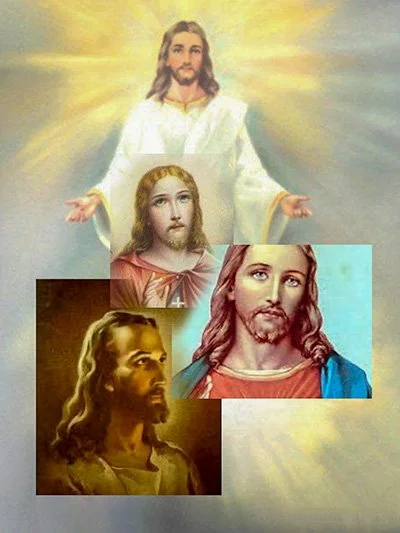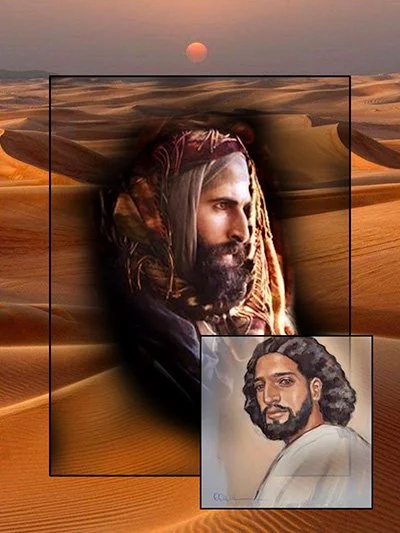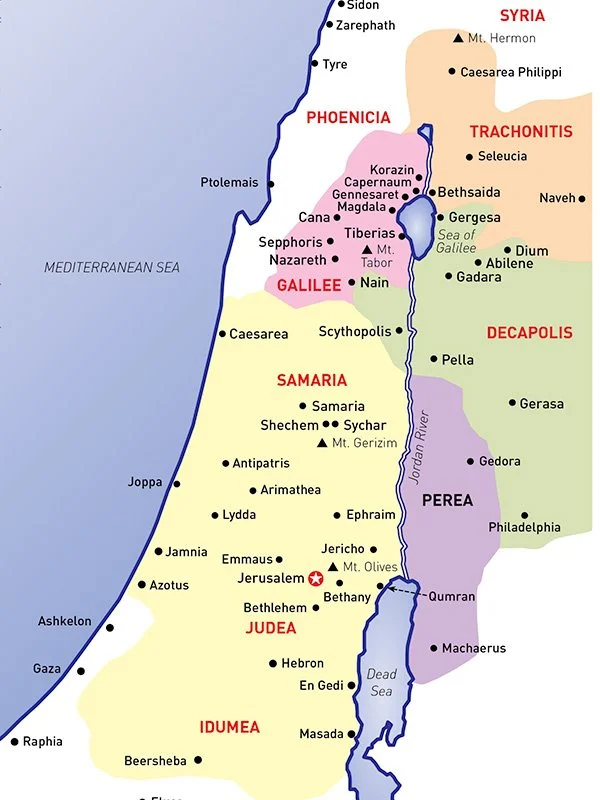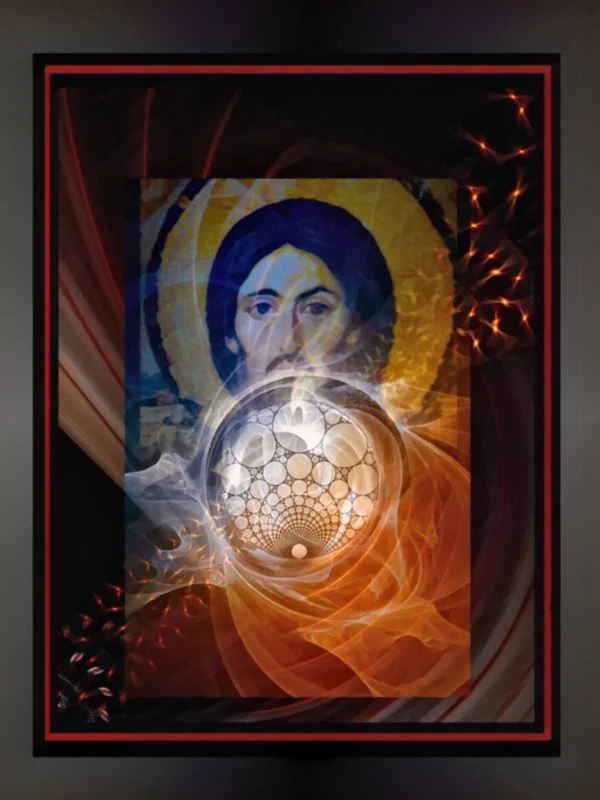
Lesson 1: Historical Foundations
In the modern western world, we have hardly known Jesus, perhaps not at all. Whether we were raised religious or in a secular home, the Jesus that we knew had been fully westernized. It was not uncommon to see a picture of him, that is still typical in many churches—the blue eyed, blond haired figure. We know, of course, it is an attempt to represent him to our cultural senses. In reality, however, that picture is totally unlike him. If Jesus ever saw it he would not recognize himself (or what he has become in the Christianity of the West). It might be better to imagine him as a figure similar to men in the Middle East.
The Western Jesus as portrayed by artists such as Warner Sallman.
Jesus as a man similar to those in the Middle East
This short course is meant to re-introduce you to that person, but in a way that is much closer to his origins in the first century than to our vision of him in the modern West. To begin, first, we must remember that the figure we call Jesus was Jewish, and never a Christian. Second, we need to reconsider his name: Jesus Christ. Neither of the two are entirely accurate. He was called Yeshua by his parents (Jesus is simply the western, Hellenic or Greek form of his name different from his original Hebrew or Aramaic one). The word Christ is not his last name. It is an important title meaning—the Anointed One. So for the record, we must begin with Yeshua, the Anointed One (from Nazareth, his hometown in Galilee). He grew up there perhaps as a very troubled child. That may also surprise you.
Let’s explore more of his historical background and his problematic upbringing. Though, by tradition, he was said to have been born in the South, in Judea (the religiously conservative part of Palestine). He was actually raised in the North, in Galilee which was a society much more open to outside influences and liberal Jewish thinking than in the southern Judaean province. He was deeply influenced, of course, by Galilee and its culture.
Palestine in the 1st Century (C.E.)
Palestine of the first Century (C.E.) was, of course, a territory under Roman occupation. Life in that era was not easy. There were ongoing and serious clashes between political and religious forces. There was also much bloodshed and suffering for common folk because of the Roman regime. His parents (Mary and Joseph—Maryam and Yousef) were good parents but also poor, caring for and raising a family in the midst of strife. They were also carrying a troubled story of family history.
A troubled family history
No one knows all the details for certain, of course, but the local story appears to be that Mary became pregnant out of wedlock, and Joseph married her out of compassion, taking her and her child under his wing. The gossip was that Mary may have been raped by a Roman soldier (by the name of Pantera) and Yeshua was the “bastard son.” That may have been both the “slur” and the wound that Yeshua grew up with and carried all his life (John 8:41).
Because of this story (the slur and the wound), Yeshua became a very different child from other children. He felt his isolation and, apparently suffered from it.This wounding seems to have driven him deeper into himself and spiritual reflection. Perhaps it sent him on a spiritual search early on that other children typically did not experience at that age. We don’t know all the details, but one narrative exists that at age 12 he stayed behind in Jerusalem after an annual visit to the Temple there to pursue and seek further—asking questions of the religious scholars of his day. When his parents finally caught back up with him, his explanation was; I must be about my Father’s business (Luke 2:49). Many possible meanings are expressed in that phrase.
The details of the years between that event and his first public appearances are unknown, but one can make some fairly reliable assumptions: he worked with his father in a carpentry business; he learned to speak the local language, Greek; in his own world he was exposed to other cultures and religious traditions (to multiple teachers passing through that region); he was deepening and growing in his personal understanding. As a result, he became deeply acquainted with the roots of his own religious traditions, gaining personal spiritual insight and wisdom throughout those early years.
Questions for Reflection
Take time to make a few notes about your personal understanding of who Jesus/Yeshua was. As you begin your reflections, compare the two sets of western and Middle Eastern images. How do they help you understand your relationship either to him or to Christianity now?
The Western Jesus as portrayed by artists such as Warner Sallman.
Jesus as a man similar to those in the Middle East
Is Yeshua of importance in your life? Why is this so? Do you understand why we might not want to use the standard name “Jesus Christ” any longer?
Palestine in the 1st Century (C.E.)
Consult the map of first century Palestine provided here, and locate the following places: the region of Galilee, the province of Judea, the town of Nazareth, city of Jerusalem, the Sea of Galilee, the Dead Sea, the Jordan River between them, and the deserts East of the Dead Sea. You might want to pick a spot that is of interest to you and do an online search and journal what you find.
For a deeper study of the issues surrounding Yeshua’s birth and family Life, explore the research done by the American writer and scholar James Tabor. Tabor’s book, The Jesus Dynasty is very helpful as well as other material online.
Here is an extensive video on the Pantera traditions:
Read the story of Yeshua in the Temple at age 12 (Luke 12:41-52) and journal your impressions and conclusions.
Eventually, Yeshua became known as a Moshel (Master of Wisdom), among other teachers of the Jewish wisdom tradition (the moshelim).
Master of Wisdom
Read the following examples of his wisdom sayings and comment on any that seem most significant to you:
All those who possess clarity of heart shall know this blessing — God will be revealed to them.
— Matthew 5:8, a contemporary translation from Koine Greek
All of nature with its forms and creatures exist together and are interwoven with each other. They will, however, be resolve back to their own proper origin,for the compositions of matter return to the original roots of their nature.Those who have ears, let them hear this.
— The Gospel of Mary Magdalene, Dialogue One, from the Luminous Gospels
…divine Reality exists inside and all around you. Only when you come to know your true Self will you be fully known—realizing at last that you are a child of the Living One. If however you never come to know who you truly are, you are a poverty-stricken being, and it is your “self” which lies impoverished.
— The Gospel of Thomas, Logion 3, from the Luminous Gospels
Blessed are all who existed before coming into being, for all who are now both existed before and shall ever be.
— The Gospel of Philip, Analogue 38, from the Luminous Gospels
Iconic image of Yeshua
Spend some time looking at this iconic image of Yeshua. It is based on a traditional icon from St. Catherine’s Monastery on Mt. Sinai. This image is meant to express what you have been reading in this chapter concerning Yeshua as a Master of Wisdom. What does it suggest about who Yeshua may have been in his day and may become in ours?
Re-Introducing Yeshua Introduction > Lesson 1: Historical Foundations > Lesson 2: His Journey




